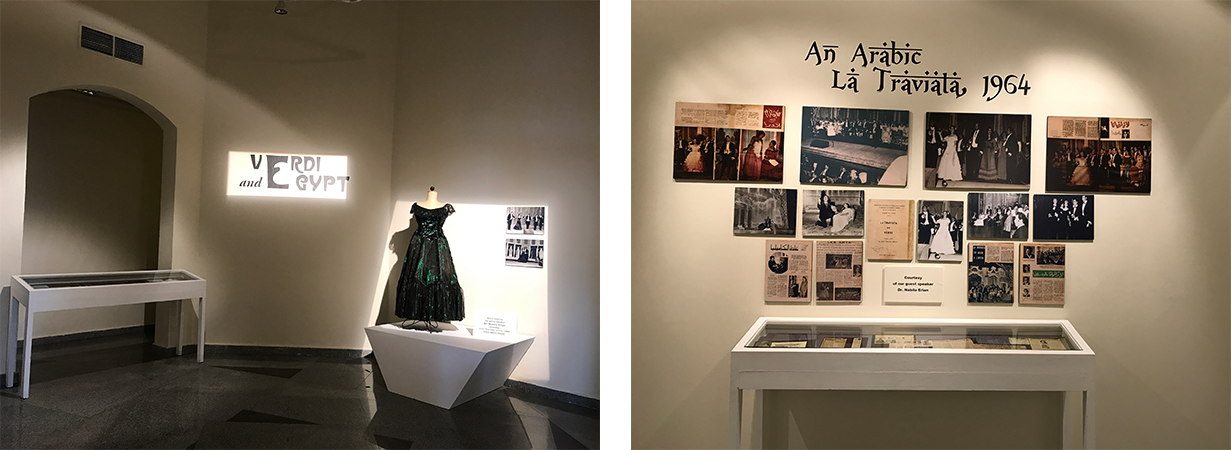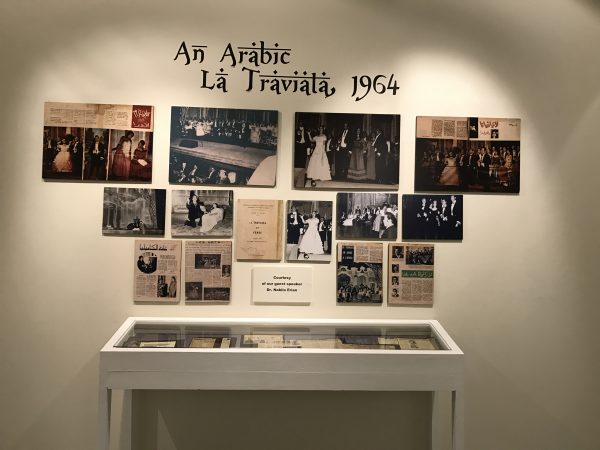
@Dootsie5
To commemorate the Metropolitan Opera live screening of La Traviata (The Fallen Woman), the School of Humanities and Social Sciences (HUSS) and the Rare Books and Special Collections Library held a joint exhibition titled “Verdi and Egypt” on March 11 at the Sharjah Art Gallery.
In collaboration with the Italian Cultural Institute in Egypt and Centre D’Etudes Alexandrines, the exhibition featured the history of the world famous opera as well as a biography about its Italian opera composer Giuseppe Verdi.
The exhibition also showcased the dark emerald-green sparkling dress worn by Nabila Erian, the lead Soprano in La Traviata’s 1964 debut at the Cairo Opera House.
The center wall of the exhibition was fully dedicated to the 1964 performance; from black and white to color, the wall was filled with old photos of the performance, the actors and the audience.
The glass gallery contained cut-out articles from the local press at the time, largely focusing on Erian mastery as a soprano despite the challenges of being a non- Italian speaker.
Finding and collecting these newspapers and photographs was not an easy task, said Associate Dean of the School of Humanities and Social Sciences Marco Pinfari.
The exhibition’s glass galleries had brochures of different librettos by Verdi and other famous composers, many of them from Pinfari’s collections in Italy.
He said it took one month to prepare the exhibition.
“Ola Seif, Reference Specialist and Curator at the Rare Books and Special Collections Library, and I tried to essentially do two things: collect material we already have and try to follow some leads in approaching archives and people,” Pinfari said.
The gallery also featured a section dedicated to the history of the Opera House’s opening under the reign of Khedive Ismail in the mid to late 18th Century.
It displayed large photos of the Khedive and Verdi, who composed the music for the opera Aida in honor of the Khedival Opera House inauguration at the time.
“The main aim of the exhibition was to explore the history of opera in Egypt, starting from the Aida duration of the Khedive theater in the early 1870s, to figure out how this impacted the cultural sphere in Egypt,” said Pinfari.
The exhibition displayed photos of different French and Italian newspapers that announced the performance of the play in Egyptian theatres.
Photos of important small theaters in Egypt, like the Zizinia Theater in Alexandria and others in Downtown Cairo in Azbakeya, were also part of the collection.
The pictures of the newspapers were taken with a high resolution camera since most of the archive material could not be reproduced.
“One thing that we knew, was that there are archives of the newspapers produced by micro communities in Cairo back at the beginning of the century. Some of them were provided to us from the archives of the Italian Cultural Center,” said Pinfari.
Scenes from the Egyptian movie Ghadet El Camilia (Lady of the Camilia), a rendition of La Traviata’s original story La Dame aux Camélias (Camille) written by Alexandre Dumas, were also on display.
“It was very interesting to see how huge the opera [crowd] was at some point in history and that we translated operas into Arabic and that we had very active opera houses in Egypt,” said Rowan Hanoo, a political science graduating senior.
La Traviata is not the first exhibition of its kind.
Last semester, HUSS held a similar exhibition when Romeo and Juliet was being screened on campus.
